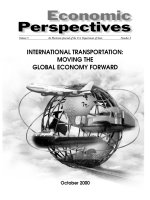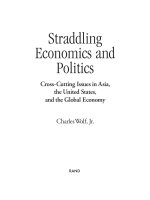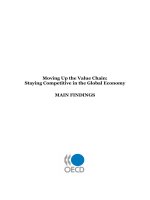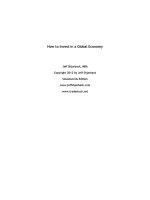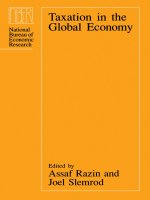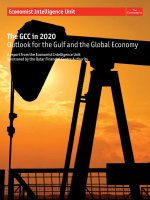Making money how taiwanese industrialists embraced the global economy
Bạn đang xem bản rút gọn của tài liệu. Xem và tải ngay bản đầy đủ của tài liệu tại đây (18.26 MB, 318 trang )
MAKING MONEY
Emerging Frontiers in the Global Economy
Editor
J.P. Singh
Series Board
Arjun Appadurai
Manuel Castells
Tyler Cowen
Christina Davis
Judith Goldstein
Deirdre McCloskey
Series Titles
Sweet Talk: Paternalism and Collective Action in North-South Trade Relations
J.P. Singh
2016
Breaking the WTO: How Emerging Powers Disrupted the Neoliberal Project
Kristen Hopewell
2016
Intra-Industry Trade: Cooperation and Conflict in the Global Political Economy
Cameron G. Thies and Timothy M. Peterson
2015
MAKING MONEY
How Taiwanese Industrialists Embraced
the Global Economy
Gar y G . Hamilton and Cheng-s hu Kao
Stanford University Press • Stanford, California
Stanford University Press
Stanford, California
© 2018 by the Board of Trustees of the Leland Stanford Junior University. All rights reserved.
No part of this book may be reproduced or transmitted in any form or by any means,
electronic or mechanical, including photocopying and recording, or in any information
storage or retrieval system without the prior written permission of Stanford University Press.
Printed in the United States of America on acid-f ree, archival-quality paper
Library of Congress Cataloging-i n-Publication Data
Names: Hamilton, Gary G., author. | Kao, Cheng-shu, author.
Title: Making money : how Taiwanese industrialists embraced the global economy /
Gary G. Hamilton and Cheng-shu Kao.
Description: Stanford, California : Stanford University Press, 2017. | Series: Emerging frontiers
in the global economy | Includes bibliographical references and index.
Identifiers: LCCN 2017015910 (print) | LCCN 2017020081 (ebook) | ISBN 9781503604452 |
ISBN 9780804792196 (cloth : alk. paper) | ISBN 9781503604278 (pbk. : alk. paper)
Subjects: LCSH: Industries—Taiwan. | Industrialization—Taiwan. | Businesspeople—Taiwan.
| Taiwan—Commerce. | Globalization—Economic aspects—Taiwan. | Taiwan—Economic
conditions—1945– Classification: LCC HC430.5 (ebook) | LCC HC430.5 .H35 2017 (print) |
DDC 338.8/8951249—dc23
LC record available at />
For our parents, who loved and supported us
and encouraged our collaboration
Glen and Ethel Hamilton
Kao Hsin and Zhong Pei-hua
This page intentionally left blank
CONTENTS
Preface
Acknowledgments
Introduction: Making Money
ix
xiii
1
Part One The Formation of a Demand-Responsive
Economy, 1965–1985
21
25
1 The Sprouts of Capitalism: Bamboo in Springtime
2 America’s Retail Revolution: The Hidden Dragon
41
58
3 Demand-Led Industrialization: Big Buyers in Taiwan
4 An Economic Way of Life: The Round Table
5 Big Business, Small Firm: Meat and Soup
84
100
Part Two Toward a New Asian Economy, 1985–2016
127
6 The Search for a New Asian Economy: The Tipping Point
131
7 High Technology Industries in Taiwan: Turning on a Dime
153
8 Consolidation in China: A New Age of Mass Production
180
9 Consolidation in China: Computers and Smartphones
212
10 Greater Taiwan, Circa 2016: The End of an Era?
233
Epilogue: The Future of Demand-Led Capitalism
247
Notes
253
Index
287
This page intentionally left blank
PREFACE
When the two of us first began our collaboration in the 1984–1985 academic
year, we thought the secret of Taiwan’s industrialization was there in front of
us, waiting to be discovered. Hamilton, a sociologist then located at the University of California, Davis, had gone to Taiwan on a Fulbright fellowship to
teach and do research at Tunghai University, located in Taichung City, the third
largest urban area in Taiwan. A member of the sociology faculty at Tunghai
University, Kao was then Chair of the Graduate Institute of Sociology. A PhD
graduate from Ohio State University, Kao was a specialist in sociological theory.
He had spent a year in the mid-1970s in Germany working on a book about
Jürgen Habermas and Max Weber. Hamilton also specialized in sociological
theory, had taught it for many years, and thought of himself as working in the
Weberian tradition.
Our initial friendship was founded on a common appreciation of Max
Weber. Weber came to early fame with his book The Protestant Ethic and the
“Spirit” of Capitalism (1904–1905), whose core thesis linked the sectarian ethic
of Protestantism to the so-called spirit of capitalism. Weber spent the last fifteen years of his life trying to provide a compelling, comparative framework
that would assess the veracity of this early work. The approach and many of the
concepts that Weber used to build this conceptual framework remain important even today, and the two of us recognized the significance of Weber’s work
in explaining Asian capitalism, even though we recognized that Weber made
errors in his interpretation of China.1
By midyear of 1985, we had begun to meet every Friday afternoon for
coffee to talk about how we might use Weber’s approach to advance an understanding of the rapid capitalist expansion then occurring in Asia and particularly in Taiwan. Gradually, the focus of our discussion shifted from theory
to the reality of Taiwan’s situation and to the recognition that we needed more
empirical knowledge about Taiwan before we could make pronouncements
x Preface
about Taiwan’s economic transformation. As the academic year came to a close,
we vowed to begin a collaborative study of Asian capitalism, and to do so, we
worked out a division of labor. Kao and his students would investigate Taiwan’s
economy firsthand by means of interviews and fieldwork with businesspeople.
Hamilton and his colleagues and students would add the comparative and historical framework that could be used to spell out the distinctive features of
Taiwan’s economy in the context of other Asian economies. Little did we realize
at the time that we would be starting a collaboration that would still be going
strong over thirty years later.
In the past thirty years, the research center that Kao started, the Institute of
East Asian Societies and Economies, has conducted in-depth interviews with
owners and managers of more than 800 firms; most of these interviews have
been transcribed. Kao and his students have visited some of these owners and
managers numerous times, usually at intervals of several years.2 Every time
Hamilton visited Taiwan, usually once or twice a year, it would be the occasion for additional interviews with some of the most revealing businesses. For
his part, Hamilton and his colleagues at University of California, Davis, also
started a research program, in the Institute of Government Affairs, to study the
comparative and institutional features of Asian economies.3
Although this division of labor led to considerable research and many publications, we discovered that capitalism is an elusive topic. We learned that it is
impossible to get capitalism to sit still long enough to locate a singular essence,
its inner logic, or even to establish a set of fixed characteristics beyond the most
general ones. Nonetheless, the results of this capitalist transformation are seen
everywhere. The results are a part of most people’s everyday lives. Because this
transformation is so elusive and yet so pervasive, we have come to think about
capitalism in light of the Chinese saying “Rising winds, surging clouds” (feng
qi yun yong). These four characters in combination signify turbulent times, an
age of transformation. A way to interpret this phrase is that we see the wind by
watching the clouds; we know a forceful movement is at hand by watching its
turbulent effects.
The spread of capitalism has transformed Asia, and this transformation is
very much like the rising winds and the surging clouds. Like the rising winds,
capitalism is an invisible force; it is everywhere and at the same time it is very
difficult to see and to grasp. We all only know capitalism by watching the swirling clouds, by recognizing its effects on people and their daily lives, on nations and their social and political institutions, on the globe and its changing
Preface xi
climate. These effects of capitalism, the swirling clouds, are not the same as
capitalism itself. To equate the two would be a mistake, but not to see the wind
as the source of the swirl is equally a mistake. We know they are related, the
wind and the clouds, but how they are related is unclear and changeable; a
great many factors combine, in different ways and at different times, to create
what we observe as the weather. It is equally so with capitalist currents in the
global economy.
This page intentionally left blank
ACKNOWLEDGMENTS
After working together and separately on this topic for over thirty years, we
have many people to thank.
Kao is extremely grateful for the funding from the National Science Council
of the Executive Yuan, now the Ministry of Science and Technology (MOST),
after being reorganized in 2014. Over eight hundred interviews with industrialists could not have been carried out without the long-term grant from the
council. Also, working with an excellent team consisting of more than a dozen
doctoral and master’s degree students was such a blessing. Among the industrialists interviewed, Kao is deeply indebted to Mr. Lai Chuan-lin, the founder
of Thunder Tiger Corporation, Mr. Lin Chun-shan, Chairman of A-PRO Tech
Co., Ltd., and Robert Tsai, CEO of The General Shoes Corporation. The repeated interviews with them have been not only informative but also inspiring,
facilitating stronger links between the academic research and industrial developments. Kao also wants to thank the many anonymous interviewees, especially those from multiple industries, for their precious time and collaboration.
For Hamilton, this book is the fifth in a series that examines the economic
organization of capitalism in East Asia. Because each book builds on the previous ones, Hamilton gratefully acknowledges research funding at various times
from the National Science Foundation, the President’s Office of the University
of California through its funding of Pacific Rim grants, the Ford Foundation,
and the Alfred P. Sloan Foundation, and further support in the form of two
professorships from the Jackson School of International Studies at the University of Washington and a Visiting Research Professorship from the University
of Hong Kong. During these years, he was also the recipient of a Guggenheim
Fellowship and a fellowship from the Center for Advanced Study in the Behavioral Sciences. He wants to recognize and thank several colleagues at the
University of California, Davis, with whom he worked closely, especially Nicole
Woolsey Biggart, the late Marco Orrù, Jean Strafford, and Robert C. Feenstra.
xiv Acknowledgments
Most importantly, the research collaboration with Feenstra provided both an
underpinning in economic theory and an understanding of the link between
the retail revolution in the United States and the industrialization of East Asia.
At the University of Washington, his collaborations with Misha Petrovic and
Solee Shin have proved invaluable. Hamilton also wishes to thank the many
graduate student research assistants who contributed to the databases he used
to contrast the ways East Asian economies are organized. These research assistants have been individually acknowledged in earlier books.
Collectively, we want to thank the Chiang Ching-Kuo Foundation for
awarding us their organization’s very first grant, which got our joint research
under way, and also for a later grant that helped us complete this book. We are
especially indebted to the Rockefeller Foundation for awarding us fellowships
at the Bellagio Study Center in Bellagio, Italy, in 2000, where we first began
working on this book. Little did we know then that it would take us this long
to complete. We also want to thank the Whiteley Center at the University of
Washington’s Friday Harbor Laboratories for awards that allowed us to work
together for two weeks during three different summers. As we entered the final
years of this project, we were extremely grateful for the research assistance of
Cindy Hsueh, without whose hard work this project might never have been
completed. In Taiwan, we want to recognize the assistance of Day Chung-bor
and Chou Hsin-yi, both on the staff at Feng Chia University, and the work and
enthusiastic support of former graduate students at Tunghai University Chang
Wei-an, Jai Ben-ray, Liu Wei-hsing, Ma Yen-bin, Tu I-ching, Wang Ming-hui,
Lin Pao-an, Chang Chia-ming, Ho Tsai-man, Wu Tsung-shen, Chen Chieh-
hsuan, Chen Chieh-ying, Chao Huei-ling, and Chen Min-lang and many of
their fellow students. In the United States, we wish to thank SUP series editor
J.P. Singh, who arranged for faculty and students at George Mason University
to read an early draft of the manuscript, and Ming Wan, who was our chief discussant. In addition, we want to thank Timothy Sturgeon, Eric Thun, and Mark
P. Dallas for reading and commenting on an earlier draft. We owe a particular
debt of gratitude to Stephan Haggard, Ho-fung Hung, and an anonymous reviewer, all of whom gave us extremely helpful guidance that led to the finished
book. Finally, we thank our in-house SUP editor, Margo Beth Fleming, who
saw the promise in our project and encouraged us along the way to completion.
During the thirty-plus years of our collaboration and friendship, our families have given us much love and encouragement and have shared our work in
so many ways. We thank them deeply. Kao especially wants to thank his sisters
Acknowledgments xv
and Cheng Ying for their long-term support. For many years, Cheng Ying has
taken care of Kao’s students like their “mother.” Hamilton thanks his wife, Eleanor Hamilton, for her love and insistence that the book be finished. Finally, we
thank our parents. Kao expresses his deepest gratitude to his parents who gave
him intellectual curiosity and a passion for life. Hamilton, too, is profoundly
grateful to his parents for encouraging him to pursue a life far beyond the Kansas farm where he was raised. From the very moment that we began working
together, both sets of parents cheered us on with their own enthusiasm about
what we would eventually produce. It is to them that we have dedicated this
book.
This page intentionally left blank
MAKING MONEY
This page intentionally left blank
1
INTRODUCTION
M a ki ng Mo ne y
It is difficult, when they are a world away from each other, to understand the
connection between American consumers and Asian manufacturers. What
most Americans hear is the unfortunate rhetoric about how some named Asian
country is undermining the US economy, how that country is using its cheap
labor, low-priced products, and manipulated exchange rates to capture if not
destroy American jobs. That named country is currently China. Thirty years
ago it was Japan. What Americans do not learn are the actual details of events
and policies leading to the decline of American manufacturing jobs and to the
huge and growing trade deficit that the United States has maintained with a
series of Asian countries since the 1980s. Despite so much information being
available in the internet age, Asia, to most Americans, remains a fog. Asian
manufacturers are usually nameless and faceless, and Asian states are mysterious, portrayed as monolithic, often authoritarian, regimes that somehow conspire against the best interests of the United States.
Caricatures aside, the decline in American manufacturing is real enough,
but the causes of that decline are less than obvious. As we will show in this
book, the changes in both the US and Asian economies are parts of larger
changes in the global economy. We push the beginnings of these changes to
1954, when in order to encourage investment in manufacturing, the US Congress passed tax-reform legislation allowing for accelerated depreciation on the
construction of “property used in . . . trade or business,” for “buildings as well
as machines.”4 On the books for the next thirty years, this new tax law pro-
2 Introduction
duced an unintended boom in the construction of shopping centers. When
the legislation was passed, there were fewer than 500 shopping centers of all
sizes in the entire United States, of which no more than two dozen qualified as
major malls.5 By 1970, after just fifteen years, the United States had over 10,000
shopping centers and hundreds of major malls. By that date, a revolution in
retailing was well under way. This tax-reform bill yielded a result opposite to
what Congress intended. It not only produced a precipitous and permanent
decline in the contribution of manufacturing to the US economy but also
kicked off the late twentieth-century transformation of the global economy.
This transformation centered more on selling products than on manufacturing
them, an approach to making money that we identify as demand-led capitalism.
This book is about that transformation, a capitalist transformation that has
engulfed the world since the end of World War II and that has left no part of
the globe untouched.
We tell the story of this transformation from the perspective of one of the
most important groups of capitalists leading the change: Taiwanese businessmen and businesswomen. Starting in the late 1960s, Taiwanese businesspeople
developed enduring relationships with large American (and later European)
retailers, such as Walmart and Target, and factory-less merchandisers, such as
Nike and Apple. By the 1980s, the Taiwanese had become the most prominent
contract manufacturers in Asia, and they remain so today, nearly forty years
later.
Most writers explaining East Asian industrialization do not differentiate
Taiwan from the four other Asian countries (Japan, South Korea, Hong Kong,
and Singapore) that, by adopting an “export orientation,” experienced rapid
economic growth in the 1970s and 1980s. From afar, these economies may look
similar, but up close, they are quite different.
Equally important, most of these writers confuse economic development
and capitalism. Economic development is a term that applies to countries; theories of economic development put forward accepted wisdom about how specific national economies grow or fail to grow and by how much. Capitalism is a
term that applies to the activities of firms methodically interacting in markets
for the purpose of making money. Most writers give much of the credit for
the success of post–World War II East Asian economies to the economic policies crafted by state planners, that is, to theories of economic development. Although national governments and national policies are important, what these
writers miss are the connections among firms that rationalize, on a global scale,
Introduction 3
the methodical pursuit of making and selling products for a profit. This dimension incorporates a story about the growth of, and tremendous changes in,
post–World War II capitalism.
During the past thirty years, we have interviewed over 800 owners and
managers of Taiwanese firms in both Taiwan and China, and followed some
of them as they, successfully or unsuccessfully, rode the waves of the global
economy for the last three decades. We interviewed some of them as many
as ten times during that period. These Taiwanese businessmen and businesswomen are among the unheralded leaders of the new global economy. One
of the most important characteristics of the global economy today is the centrality of retailers and merchandisers that contract most or all of their manufacturing from firms they do not own. We use the term big buyers to identify
these retailers and merchandisers,6 and we call the firms where they place their
orders contract manufacturers. For most of the last fifty years, Taiwanese businesspeople have been responsible for a sizable percentage of contract manufacturing worldwide. Just how large this percentage is varies over time, but we can
get some sense of it by knowing that, in 2012, ten of the top twenty exporters
from China were Taiwanese companies, all contract manufacturers.7 Another
indication of Taiwanese companies’ global prominence is the 2013 Manufacturing Market Insider’s list of the world’s top contract manufacturers, showing
that Taiwanese businesspeople own three of the top five and four of the top
ten companies on that list.8 By contrast, Mainland Chinese own only one of
the top ten firms on the list, Americans three firms, Canadians one, and Singaporeans one. Even the most prominent Taiwanese companies on these lists are
little known outside Taiwan because they do not sell products under their own
names, but rather are the main manufacturers for major US merchandisers of
consumer electronics, such as Apple and Dell. Other major contract manufacturers in Taiwan produce a huge array of products, including most of the
world’s footwear and many of the private label goods sold by major American
retailers, such as Walmart, Target, Costco, and Home Depot.
The “Made in China” label that identifies China as these products’ country
of origin does not tell us who owns the firms making those products, and many
of those firms are Taiwanese owned. The largest Taiwanese contract manufacturers in China are only the tip of a huge iceberg. There are around one million
Taiwanese living in China, 9 most of whom are associated with the 90,000 plus
Taiwanese firms currently registered in China.10 Most of these firms are engaged in contract manufacturing, either assembling the final product or mak-
4 Introduction
ing some component that will go into a final product or providing a service to
firms making those products. If we add all the exports produced by Taiwanese
firms in China to the exports from firms in Taiwan, then Taiwanese businesses
make up the largest single group of contract manufacturers in the world.
Taiwan’s entry into contract manufacturing began in the late 1960s. From
the outset of industrialization in Taiwan until around 2000, the value of Taiwan’s exports to the United States exceeded the value of South Korea’s exports,
even though South Korea has more than twice the population, geographical
size, and gross national product (GNP).11 By 2000, however, most of the largest
Taiwanese exporters had moved some or all of their manufacturing operations
to China, which allowed South Korean exporters, most of whom maintained
their primary manufacturing plants in South Korea, to surpass Taiwan’s level of
exports. After the 1980s, however, the largest business groups in South Korea,
namely Samsung, Hyundai, and Lucky-Goldstar (LG), moved away from contract manufacturing and began to build their own brand names, with products
they designed, manufactured, and merchandised. Still, were we to total all the
exports of Taiwanese-owned firms, regardless of their location, this sum would
certainly exceed the total exports of Korean-owned firms, which include cars
from Hyundai and smartphones from Samsung and LG.
Taiwan is a small and rather odd location for businesspeople who are so
globally prominent. It is a mountainous island located off the southeastern
coast of China. Its population is slightly over 23 million, smaller than New York
State’s, somewhat larger than Texas’s, and a dwarf beside Mainland China’s 1.3
billion. Since the 1970s, the global community of nations has not recognized
Taiwan as an independent country. That was when nations around the world,
including the United States, normalized their diplomatic relations with Mainland China. Because China claims Taiwan as one of its provinces, and because
China requires all nations with which it has diplomatic relations not to recognize Taiwan as an independent state, Taiwan became a political isolate. Unlike
the Vatican and Palestine, Taiwan has not been granted even the status of an
observer state by the United Nations. Nonetheless, in all other respects, Taiwan
is an independent country, and among the most economically advanced and
politically progressive countries in Asia.
How did people from this small country become so integral to the global
economy in the second half of the twentieth century? That is the question we
answer in this book. An essential part of that answer is the story of global capitalism itself in the last sixty years, but another, no less important part of the
Introduction 5
answer includes some special characteristics that allowed Taiwanese businesspeople to create their own, very successful forms of contract manufacturing.
These characteristics, mostly social in nature, shaped their fortuitous beginnings and gave them enough organizational flexibility to make money in a constantly changing global economy.
In the following pages, we introduce these characteristics with accounts of
two businessmen who met very different fates in their quest to make money.
The Commanding General of Low-F lying Planes
The first time we met Lai Chuan-lin, in 1990, he told us, “I am the Commanding General of everything that flies in the United States under two hundred feet.” He laughed when he said this, but he was also serious. We stood in
the showroom of his company, Thunder Tiger, located in an industrial park
near Taichung, in central Taiwan. Examining model after model of remote-
controlled, propeller-driven airplanes, Mr. Lai explained, “With the exception
of one Japanese company, I supply all of the major toy companies in the US
with almost all of the remote-control planes they sell. The Japanese-made
planes may be better built and more expensive than mine, but my company
commands the market.”
Since that first visit, we have returned to Thunder Tiger many times, and
each time it seems like a new company. By the time of our second visit, in 1993,
Lai had moved major portions of his manufacturing to Ningbo, in Mainland
China, and in his factory in Taiwan, he had begun experimenting with new
types of model airplanes. When we returned in 1994, he told us that the Mainland factory was turning out model airplanes at full capacity, and at his factory
in Taiwan, he had developed a jet engine for his model planes and had begun
making planes with these engines for specialized model airplane enthusiasts.
By the 1996 visit, he had found the Mainland manufacturing site to be so well
located, in terms of labor and resources, that he had established an industrial
park and a property company so that he could attract other Taiwanese manufacturers to the same location.
When we returned to Thunder Tiger in 1997, Lai Chuan-lin was in China
promoting the industrial park, but his wife, Hsieh Tsai-yun, showed us around.
Hsieh, the general manager of Thunder Tiger, takes care of the books, supervises the labor, and is in full charge of the family firm when her husband is
away, as he often was in those days when he was getting the Mainland busi-
6 Introduction
nesses established. Showing us around the factory and introducing the new
workers from Thailand to us by name, Hsieh told us that the jet engines did
not have a ready market among hobbyists, and so they had stopped production
of the jet engine targeted at that market. But, Hsieh explained, “The military
is interested in our jet engines now.” “The military?” we said. Quietly, she told
us that it was not only the Taiwanese military, but also a foreign air force that
had contacted the company, and that they wanted the engines and the remote-
control devices for drones that could confuse heat-seeking missiles in times of
military combat. To satisfy the military interest, they had upgraded the engine
from a five-pound version to one weighing up to fifty pounds. These bigger
engines carried sufficient thrust to power much larger aircraft than just toy
airplanes. In the end, Lai signed an exclusive, well-compensated contract with
Taiwan’s military, but as we later learned, nothing substantial emerged from
this contract, except the company’s promise not to manufacture jet engines and
control devices commercially until 2015.
When we returned to Thunder Tiger in 1999, Lai had started making component parts for full-sized airplanes. The composite material that he had used
to make the jet engines turned out to be well suited for high-stress areas on
many kinds of commercial and military airplanes. He had the manufacturing
experience and the research and development skills to win bids for very lucrative orders. In passing, he also told us that he had been elected president of
Taiwan’s toy manufacturers’ association. Smiling, he said, “I still make toys, but
I am not sure my business should be classified that way. I am in the airplane
business. I always have been.”
By the time of our visit in the fall of 2005, Thunder Tiger had changed again.
No longer was Lai just in the airplane business. His remote toy automobile
operation had greatly expanded. He had gotten the contract to manufacture
about 50 percent of all radio-controlled race cars sold by Associated Electrics,
which at that time was the world’s top brand in this niche market. Also a leading brand name in its own right, Thunder Tiger made radio-controlled cars
not only under its own brand name but also for its chief competitor. In 2005,
when the President of Associated Electrics retired, Lai and his wife bought
Associated Electrics, to become the world’s leading producer in both remote-
controlled airplanes and remote-controlled cars. Also in 2005, Lai and his wife
listed Thunder Tiger on Taiwan’s stock exchange. The initial public offering
was very well accepted, with the share price doubling in less than a year.
When we talked with Lai Chuan-lin in 2009, he was less upbeat. The United
